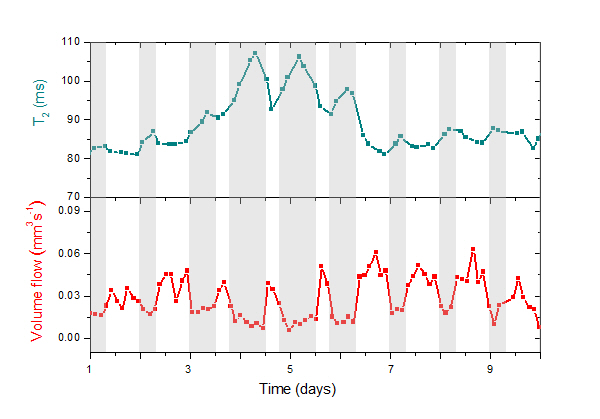Transport in phloem tissue
- Wageningen University, Biophysics, Wageningen, Netherlands
Phloem vascular tissue transports phloem sap from source leaves to sinks, i.e., areas of growth and/or storage. The phloem sap consists mainly of water and sucrose, transported in very small amounts (μL) and at very slow velocities (around 200 μm s-1). Therefore, phloem flow is difficult to measure. Only MRI is the truly non-invasive technique to measure phloem flow.
Windt et al. [1] showed that Pulse Field Gradient Turbo Spin Echo (PFG-TSE) [2] pulse sequence is suitable for phloem flow measurement. PFG-TSE combines MR-imaging with q-space imaging which results in a probability of displacement, a propagator, for every pixel. The propagator contains information about the velocity of phloem sap flow, the area of actual flow, i.e., the flow conducting area (FCA), and the area with stationary, only diffusing water. From velocity and FCA the volume flow of phloem sap is obtained. Windt demonstrated MRI phloem flow measurement over a time-course of 35 hours. However, the behaviour of phloem flow over longer periods of time during an adaptation to different abiotic conditions, e.g. different photosynthetic active radiation (PAR) intensity, is unknown. Furthermore, the impact of PAR length on sucrose concentration in the phloem sap in vivo has also yet to be demonstrated.
We consecutively measured phloem and xylem flow with the PFG-TSE pulse sequence and T2 with the Multi Spin Echo (MSE) [3] pulse sequence, and we optimized and compared analysis procedures. In our study we show that T2 of water in the region of phloem flow is most likely correlated with sucrose concentration in the phloem sap. Sucrose concentration appears to reflect the phloem flow diurnal behaviour, i.e., higher concentration of sucrose during the day and lower concentration of sucrose during the night. Our results disprove a hypothesis about constant phloem sap velocity and phloem sap sucrose concentration over day/night period.

- [1] Windt, C.W et al., (2006), MRI of long-distance water transport: a comparison of the phloem and xylem flow characteristics and dynamics in poplar, castor bean, tomato and tobacco., Plant, Cell and Environment , 1715-1729
- [2] Scheenen T.W.J. et al., (2000), Microscopic displacement imaging with pulsed field gradient turbo spin-echo NMR., Journal of Magnetic Resonance , 207-215
- [3] Edzes H.T. et al., (1998), Quantitative T2 imaging of plant tissues by means of multi-echo MRI microscopy., Magnetic Resonance Imaging , 185-196
